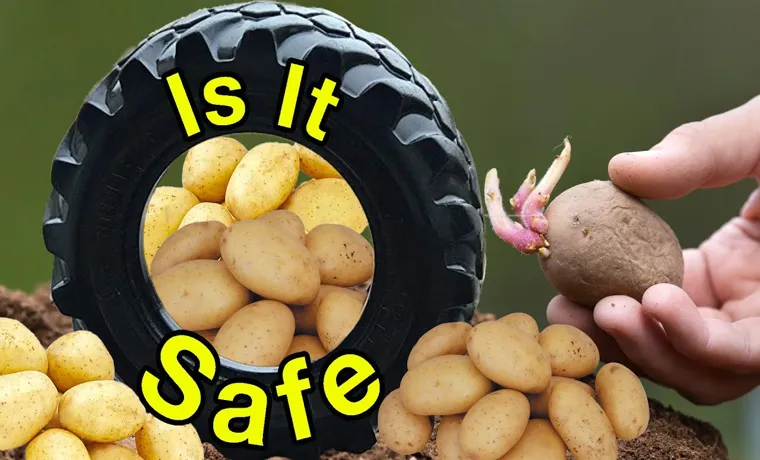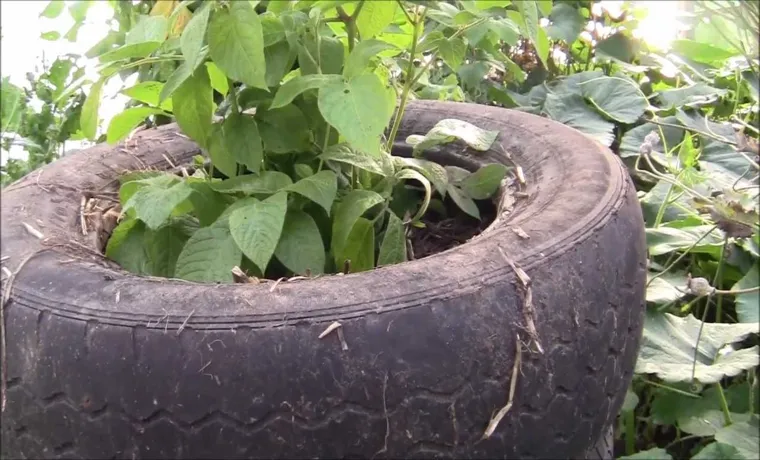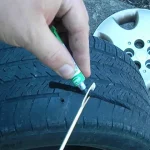Potatoes are a versatile and beloved staple food, enjoyed by millions around the world in various forms. Whether mashed, roasted, boiled, or fried, potatoes offer a satisfying and filling addition to any meal. However, growing potatoes can be a challenge, especially for those lacking yard space or access to a traditional garden.
Luckily, there’s a simple and efficient method that doesn’t require much space or effort: growing potatoes in a tire. Yes, you read that right – using tires to grow potatoes is a popular and effective gardening technique that has been embraced by many amateur and professional gardeners alike. The process involves layering soil and potato seedlings inside a tire, adding more soil as the plants grow taller, and finally harvesting delicious homegrown potatoes when they’re ready.
But why grow potatoes in a tire, you ask? Well, for starters, it’s a great way to maximize space in a small garden or balcony. Tires are affordable and easy to come by, and they provide a contained space for your potato plants to grow without spreading out too much. In addition, the dark color of the tire absorbs and retains heat, creating a warm and conducive environment for the potatoes to thrive.
Of course, you’ll need to follow some steps and take certain precautions to ensure a successful potato harvest. Choosing the right type of tire (avoiding those made with toxic materials), using high-quality soil, watering and fertilizing appropriately, and watching out for pests and diseases are all key components of the process. But with a bit of dedication and effort, you can enjoy a bountiful harvest of fresh, healthy, and sustainable potatoes grown right in your own backyard (or balcony!).
So why not try out this innovative and resourceful way of growing potatoes? Who knows – it may just become your new favorite gardening technique!
Table of Contents
Choosing the Right Tires
If you’re looking for an easy way to grow potatoes, consider using a tire as a container. It’s a simple process that only requires a few materials. Firstly, you’ll need a tire that’s free of chemicals and contaminants.
Next, fill the tire with soil, leaving about six inches of space at the top. Cut the seed potatoes into pieces with at least one eye each and plant them in the soil with the eye facing up. Cover the potatoes with soil and water them well.
As they grow, continue adding soil until the tire is full and the stems start to poke out of the top. This method is great for small spaces or areas with poor soil quality, as the tire provides an enclosed space with good drainage. Plus, it’s a fun way to repurpose an old tire! So go ahead and give it a try, you might be surprised at how easy and rewarding it can be to grow potatoes in a tire.
Selecting Tires with Optimum Drainage and Sunlight Exposure
When it comes to selecting tires, it’s important to consider their optimum drainage and sunlight exposure. The right tires can make a big difference in how well your vehicle performs in different weather conditions. For example, if you live in an area with heavy rainfall, you’ll want tires with excellent drainage capabilities to prevent hydroplaning and skidding.
Tires with wider grooves or channels can help to channel water away from the surface of the tire, improving traction on wet roads. On the other hand, if you live in a hot and sunny climate, you’ll want tires that can withstand long periods of exposure to UV rays. Over time, exposure to sunlight can cause tires to crack and deteriorate, which can impact their performance and safety.
Look for tires with UV-resistant technology or those that are designed for high-performance driving in hot climates. By choosing the right tires, you can improve your vehicle’s handling, safety, and overall performance.

Preparing the Tires
When it comes to growing potatoes in a tire, preparation is key. First, select a tire that is at least four feet wide and two feet tall. Then, thoroughly clean the tire to remove any dirt or debris.
Once clean, drill drainage holes about two inches in diameter in the bottom of the tire. Next, fill the tire halfway with a loose soil mixture rich in nutrients. A good mixture may include compost, topsoil, and peat moss.
Pack the soil down firmly and add a layer of straw or leaves to help with drainage. Finally, add another layer of soil on top, leaving about four inches of space until the rim of the tire. With your tire prepared, you are now ready to start planting your seed potatoes and watch them grow!
Cleaning and Cutting the Tires for Optimal Planting Space
Preparing the tires is an essential step in creating optimal planting space. Before using the tires to start a garden, they should be cleaned and cut into the desired shape. You can start by washing the tires to remove any dirt, debris, or chemicals that may be present.
Once the tires are clean, it’s time to start cutting them to create planting space or a flower bed. Cutting the tires is not a difficult task, but it requires some precaution. You can use a saw or a sharp knife to cut the tires into the desired shape and size.
It’s important to wear gloves and protective clothing when cutting the tires to prevent injuries and exposure to chemicals. By preparing the tires properly, you can create an attractive and productive garden in a small space. With a little effort, you can enjoy gardening even in limited space.
Planting the Potatoes
Growing potatoes in an old tire is an innovative way to utilize waste and grow a tasty crop. To begin, fill the tire with soil until it’s about two inches from the rim. Then, place your seed potatoes on top of the soil, spacing them several inches apart.
Be sure to leave at least six inches of space between the potatoes and the tire wall. Cover the potatoes with four to six inches of soil, water them thoroughly, and wait for them to sprout. As the potato plants grow, continue to cover the stems with soil and add more soil to the tire until it’s filled to the top.
The potato plants will eventually flower and begin to die back, which is the signal that they’re ready to harvest. Carefully dig out the potatoes from the soil, and you’ll have a bountiful crop that’s ready to be roasted, mashed, or cooked in your favorite dish! Growing potatoes in an old tire is an easy, fun, and eco-friendly way to get delicious tubers.
Adding Layers of Soil and Seed Potatoes to the Tires
After filling up our tires with soil and compost, it’s finally time to plant the seed potatoes! First, we need to make sure that there are at least four to six inches of soil in each tire. Once we have enough soil, we can begin planting the potatoes. We start by placing the seed potatoes on top of the soil, with the eyes facing up.
The eyes are the small indentations on the potato’s surface, which will eventually grow into the new plant. We aim to space them out about 6 inches apart, to give each plant enough room to grow. Then, we cover the seed potatoes with a few inches of soil, making sure they are well covered.
Over the next few weeks, the potato seedlings will begin to grow and push their way up through the soil. It’s important to keep an eye on the potatoes and regularly add more soil as they grow taller, to make sure they are well supported. As with any gardening endeavor, patience is key, and we can’t wait to see our potato tower garden thrive!
Caring for Your Potato Plants
Growing potatoes in a tire is an efficient way to cultivate potatoes for your home’s consumption. However, caring for the plants is just as crucial as planting them. The first step is to keep the soil moist but not waterlogged.
Potatoes require water to grow, but excessive water can lead to rotting and stunted growth. Ensure the soil has good drainage and space the tires apart to avoid any waterlogging of the soil between them. Fertilizing the plants at regular intervals is also crucial to ensure the potatoes have enough nutrients to thrive.
You can use organic fertilizers or compost to enrich the soil’s quality. Additionally, potato plants tend to attract pests and diseases, so inspect your plants regularly to nip any potential issues in the bud. By taking good care of your potato plants, you can ensure a bountiful harvest of delicious spuds.
Watering, Fertilizing, and Managing Pests and Diseases
When it comes to caring for your potato plants, proper watering, fertilizing, and managing pests and diseases are all crucial elements. Potatoes require consistent moisture in the soil and should be watered thoroughly once a week. However, be careful not to overwater them, as this can lead to rot and disease.
Fertilization should be done early in the season to promote healthy growth and yield. You can use a balanced fertilizer or a specialized blend for potatoes. Managing pests and diseases can be a challenge, but it’s important to stay vigilant and catch any issues early on.
Common potato pests include aphids, potato beetles, and mites. Diseases like blight can also impact your crop, so regular inspections and treatments may be necessary. By giving your potato plants the care they need, you can enjoy a bountiful harvest of delicious tubers!
Harvesting Your Potatoes
Once your potato plants have flowered and the foliage has died back, it’s time to harvest your delicious tubers! If you’ve followed the method of growing potatoes in a tire, you might have some questions about how to best harvest them. Luckily, it’s quite simple! Carefully slide the tire up and away from the soil to expose the potato plants. Gently dig up the soil around the base of the plant using a garden fork or trowel.
Be careful not to cut into any of the potatoes as you dig. You can also use your hands to gently feel around the soil for any missed potatoes. Once all of the potatoes are harvested, brush off any excess dirt and allow them to dry in a cool, dark place before storing.
With just a tire and some potatoes, you can enjoy a bountiful harvest of home-grown spuds!
When to Harvest, and How to Retrieve Potatoes from Each Tire
Harvesting potatoes from your tire garden can be a rewarding experience, but it’s important to know when and how to do it properly to ensure a bountiful harvest. Potatoes are typically ready to harvest when the plants have died back and the leaves have turned yellow. This usually occurs around 10-12 weeks after planting.
To retrieve the potatoes, gently lift the tire and use your hands to sift through the soil. Be careful not to damage the potatoes as you retrieve them. It’s important to harvest all of the potatoes as leaving any behind can attract pests or disease.
The number of potatoes you’ll get from each tire will vary depending on the size of the tire and the number of plants you’ve grown. It’s best to leave the tires in place for a few days after harvesting to allow any remaining potatoes to continue to mature before retrieving them. Happy harvesting!
Conclusion
In the end, growing potatoes in a tire is a unique and practical gardening technique. Not only does it save space and provide gorgeous greenery to any outdoor setting, but it’s also an eco-friendly way to repurpose old tires. So why not give it a try and join the growing community of tire-tater enthusiasts? One thing’s for sure – you’ll definitely be the talk of the neighborhood with your witty and clever garden set up.
“
Benefits of Growing Potatoes in Tires, and Tips for Further Experimentation
As exciting as it can be to watch your potato plants grow over time, the real magic happens when it’s time to harvest those spuds. To ensure your potatoes are at their ripest for picking, you should monitor the foliage of your plants. When the foliage begins to die off and turn yellow, it’s a sign that the potatoes are ready to be dug up.
Be sure to use a garden fork or spade to gently dig around the edges of the tire stack, being mindful not to damage any of the potatoes in the process. Once you’ve successfully harvested your potatoes, be sure to let them cure by leaving them in a cool, dry place for about a week to allow the skins to toughen up and prevent spoilage. By growing potatoes in tires, you not only have an eco-friendlier option compared to traditional methods, but you also have the chance to experiment with different variations.
For example, try changing the soil composition or the shape and size of the tire stack to see how it affects growth and yield. With a little trial and error, you might even surprise yourself with a new method for producing bumper crops of potatoes.
FAQs
What type of tire is best for growing potatoes?
Any tire can be used as long as it is not made of steel and is about 2-3 feet in diameter.
How many potatoes can be grown in a single tire?
About 4-6 seed potatoes can be grown in a single tire.
What type of soil is best for growing potatoes in a tire?
Potatoes grow best in a loose, well-drained soil that is rich in organic matter.
How often should I water my potato plants in a tire?
Water the potato plants once or twice a week depending on the weather and soil condition.
Can I reuse the tire for growing potatoes next year?
It’s not recommended to reuse the same tire for growing potatoes as it may contain harmful chemicals from the previous crop.
When should I plant my potatoes in the tire?
The best time to plant potatoes in a tire is in the early spring, once the soil has warmed up.
How do I prevent pests and diseases from attacking my potato plants in a tire?
To prevent pests and diseases, keep the area around the tires clean, rotate crops, and practice good watering and fertilization techniques.



